
 Environmental Protection311
Environmental Protection311 Search all NYC.gov websites
Search all NYC.gov websites
Types of Green Infrastructure
In New York City, Green Infrastructure describes an array of practices that use or mimic natural systems to manage stormwater runoff. Green Infrastructure controls stormwater by using it as a resource rather than a waste. Stormwater is either directed to engineered systems for infiltration or detained at a slower rate before it enters the Sewer System. View our Green Infrastructure Animation and Photos for more information.
Rain Gardens

The word rain garden is generally used to describe planted areas that collect rainwater. We use the term rain garden to describe planted areas in the sidewalk that are designed to collect and manage stormwater. Rain gardens are vegetated or landscaped depressions designed with an engineered soil layer that promote infiltration of stormwater runoff into the underlying soil. Learn more about Rain Gardens.
Infiltration Basins

Infiltration Basins are designed to store stormwater beneath a surface that closely mimics its surroundings, like grass or concrete. They are similar in functionality to Rain Gardens. The inlet opening on the curb face collects the stormwater, which fills a chamber, or sump. Once the sump is partially filled, openings on its walls feed into pipes, which convey the stormwater to an underlying stone layer; the stormwater then seeps into the ground underneath in a process called infiltration. Download our Green Infrastructure Infiltration Basin Design.
Stormwater Greenstreets and Medians

Stormwater greenstreets and medians, like Rain Gardens, are planted areas designed to collect and manage stormwater that runs off the streets and sidewalks, but are typically larger than rain gardens, and have varying lengths, widths and soil depths based on the characteristics of the existing roadway.
Green Roofs

Green roofs are made up of a top vegetative layer that grows in an engineered soil, which sits on top of a drainage layer. A green roof can be intensive, with thicker soils that support a wide variety of plants, or extensive, covered in only a light layer of soil and minimal vegetation. Through the Green Infrastructure Grant Program, DEP supports property owners with financial incentives to install green roofs.
Blue Roofs

Blue roofs are designed without vegetation for the primary purpose of detaining stormwater. Weirs at the roof drain inlets create temporary ponding and gradual release of stormwater.
Permeable Pavers and Porous Pavement

Permeable paving is a range of materials and techniques, such as permeable pavers or porous pavement, which allow water to seep in between the paving materials and be absorbed into the ground. Permeable paving can be used instead of traditional impermeable concrete or asphalt.
Download the Porous Pavement in NYC Brochure
Subsurface Detention Systems

Subsurface Detention Systems with infiltration capability provide temporary storage of stormwater runoff underground. These systems have an open-bottom and can incorporate perforated pipe and stormwater chambers for added detention volume. Systems are primarily designed with a gravel bed that stores water until it can infiltrate into the ground.
Rain Barrels and Cisterns

Rain barrels and cisterns are watertight receptacles designed to catch and store stormwater off of roofs and other impervious surfaces. Cisterns are often larger than rain barrels and can be located underground, at ground level, or on an elevated stand. Rain barrels are connected to the existing downspout of a roof and reuse the stormwater for watering plants and other landscaping uses.
Wetlands

Wetlands are transitional lands between aquatic and terrestrial ecosystems that provide many ecological, economic, and cultural benefits. They attenuate flooding, help maintain stream flow, provide erosion control and water filtration, and are important natural habitats for fish and other wildlife. DEP works to restore and enhance wetlands to improve water quality and foster local ecosystems. These efforts are part of a citywide wetlands strategy that addresses development, pollution, and climate change by proposing initiatives that protect, restore, and assess wetlands in collaboration with state and federal partners.


